At the 2021 Shanghai Auto Show, Huawei shocked all automakers and suppliers. Huawei has directly and indirectly supported more than 10,000 engineers in the R&D of intelligent automobiles. Except production, Huawei covers almost all of aspects required for digital transformation of automobiles: automotive perception and decision-making, network communications, electric drive, batteries, electric control, cloud-road networks outside vehicles, R&D and marketing.
Compared with the previous R&D investment involved with 1,000 persons (such as Baidu), Huawei's R&D team consisting of 10,000 persons has greatly accelerated the upgrade pace of intelligent networking of China's auto industry. When other countries around the world are still worrying about the pandemic, China will enter the era of leading the development of global automotive intelligent networking from 2021.
Take LiDAR installation as an example, the new models with LiDAR mainly come from domestic automakers.
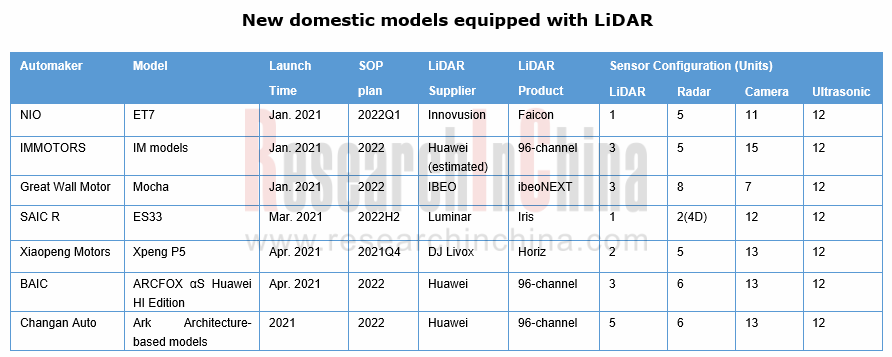
On April 14, Xpeng's third mass production car, the P5, was launched. The biggest highlight is that it is equipped with two DJI Livox LiDARs, which can realize the NGP function on urban roads. Following NIO ET7, Great Wall Mocha, IM and SAIC ES33, P5 is another new model equipped with LiDAR.
On April 17, the ARCFOX Alpha S Huawei HI equipped with three Huawei’s 96-channel LiDARs (installed on the center and both sides of the front) was officially unveiled; later, Changan’s model based on the Ark architecture will also be equipped with Huawei’s LiDAR.
The second model of Lixiang will also be equipped with LiDAR.
After years of development, automotive LiDAR technology roadmaps and products have been quite diversified. ResearchInChina has sorted out classification and composition of LiDAR, as shown in the figure below.
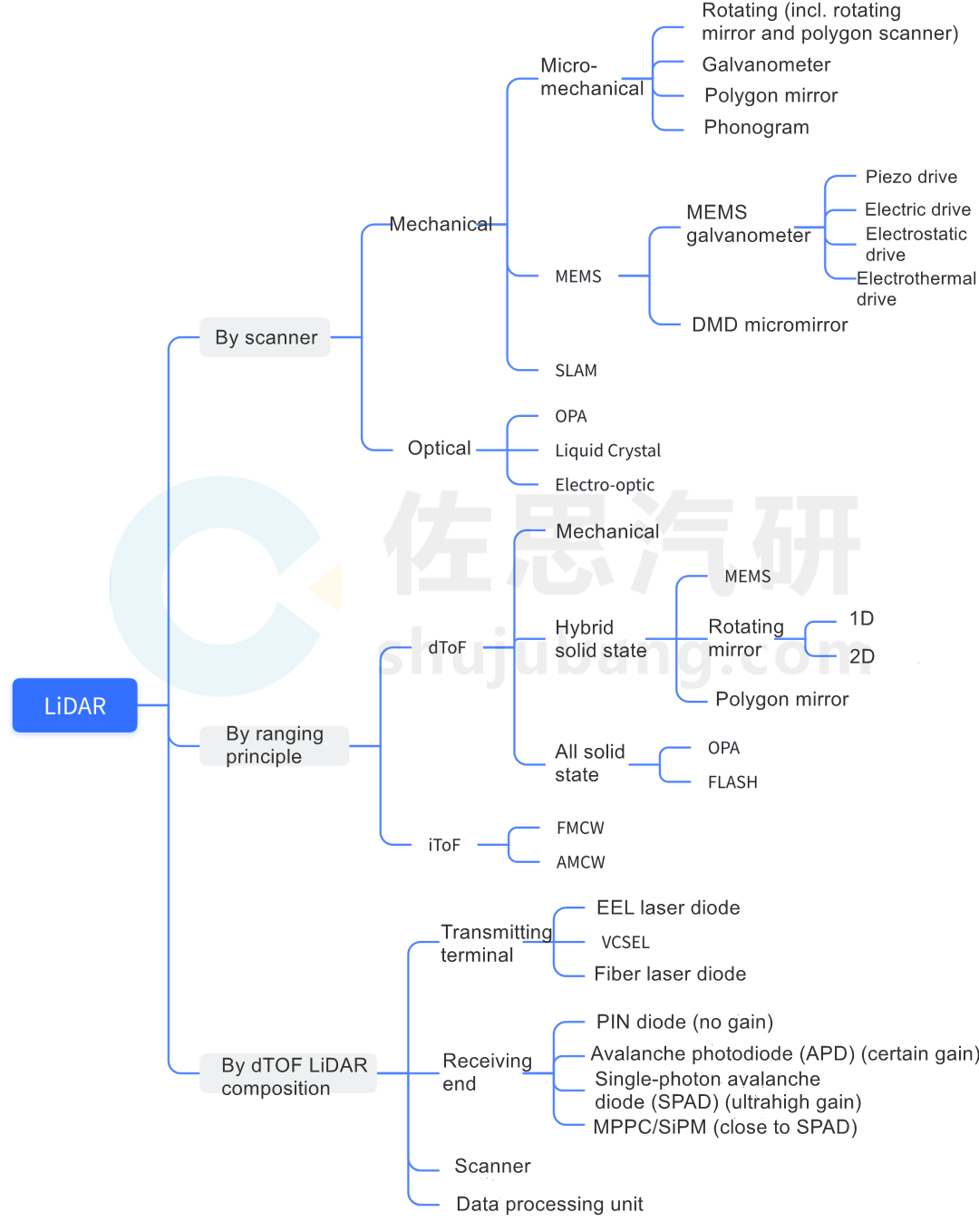
Early, LiDAR was mainly used in Robotaxi, Robotruck, Robobus, low-speed autonomous driving and roadside perception, etc. in small scale. The extensive application of LiDAR depends on the passenger car market.
As L4 technical solutions are gradually applied to L2-L3 models, LiDAR has been installed widely. LiDAR is currently available on production cars, and is mainly used to enhance ADAS functions and make new cars more appealing.
So far, domestic OEMs prefer to adopt hybrid solid-state LiDAR (including rotating mirror, prism, MEMS) solutions, mainly because:
First, it is easier to reduce the costs of hybrid solid-state LiDAR than mechanical LiDAR. Compared with pure solid-state (OPA, Flash) LiDAR, hybrid solid-state LiDAR technology is relatively mature and easier to commercialize.
Second, the Rotating Mirror Solution (represented by Valeo) is the first technical solution that meets National Automotive Standards and the performance requirements of automakers, and can be supplied in batches with controllable costs.
Xpeng P5 is equipped with two LiDARs (installed on both sides of the front bumper) from DJI Livox Horiz (customized version), which use the dual prism scanning solution, with the maximum detection distance of 150m (@10% reflectivity), the lateral field of view of 120 degrees, the angular resolution of 0.16°*0.2°, and the point cloud density equivalent to 144-channel LiDAR.
Xpeng Livox LiDAR uses 905nm wavelength at the transmitting side, APD at the receiving side, and double prism at the scanning side, namely Risley prism universal pointing system, with a unique non-repetitive scanning method.
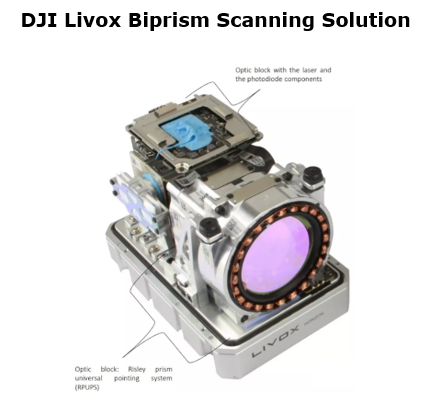
ARCFOX Alpha S Huawei HI is the first model equipped with Huawei’s three 96-channel LiDARs on the center and both sides of the front. Released in December 2020, the LiDAR has the maximum detection distance of 150m (@10% reflectivity), the field of view of 120°×25°, and the resolution of 0.25°×0.26°.
Combined with other sensors (6 radars, and 13 cameras and 12 ultrasonic radars), the LiDARs can achieve 360° coverage.
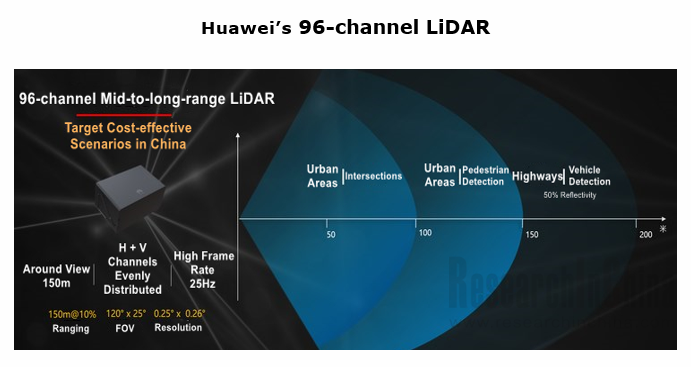
Huawei deploys long, medium and short-range LiDARs with a rotating mirror scanning architecture. Like Valeo Scala 1, Scala 2, the LiDARs comply with National Automotive Standards and are available on cars.
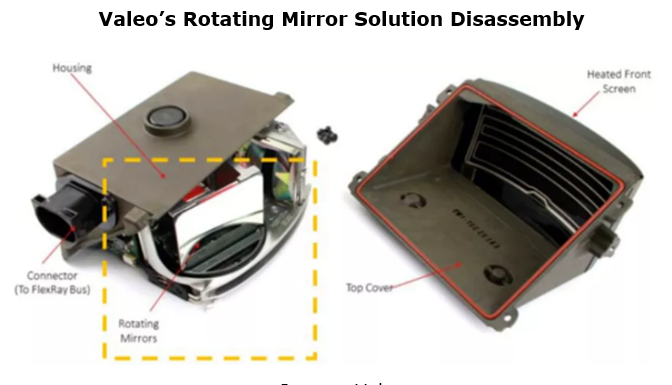
In addition to Huawei and Valeo, Innovusion and Luminar adopt similar technical solutions which however exploit two-axis rotating mirror scanning. They will soon conduct mass production for NIO ET7 and SAIC R ES33.
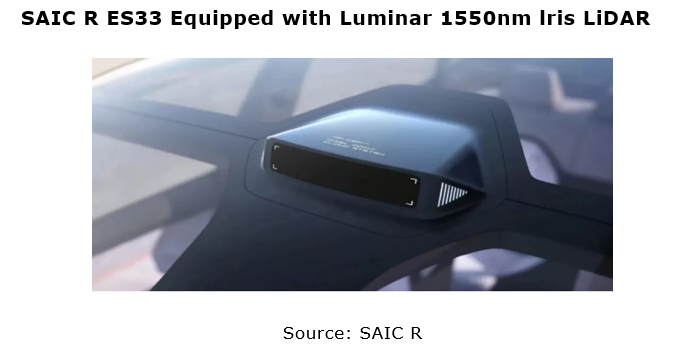
Luminar LiDAR features unique technical advantages: 1550nm wavelength (mainstream: 905nm) at the transmitting side, the low-cost InGaAs detector at the receiving side, self-made fourth-generation custom ASIC chips, and a 2D rotating mirror scanning method.
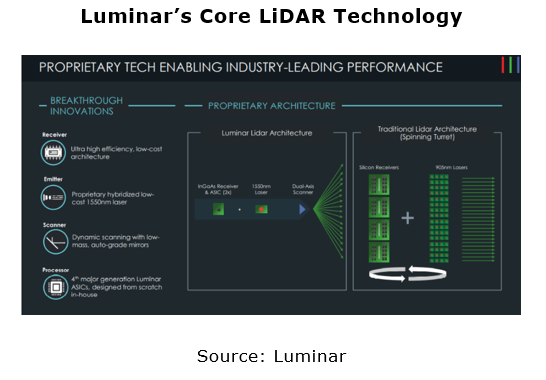
Luminar's Iris LiDAR based on this architecture has a detection distance of up to 250m (@5% reflectivity), and can detect dark objects on the road beyond 250m, with the resolution of up to 300PPD and the angular resolution of 120°×30°. At the same time, it has low costs. The price of IRIS for L2 advanced assisted driving is US$500; for L4/L5autonomous driving, it is less than US$1,000.
Innovusion and Luminar are alike in technology path. Both use 1550nm wavelength, fiber laser, and dual-axis rotating mirror scanning solution.
In January 2021, NIO ET7 was released, equipped with Innovusion's Falcon LiDAR. It will be mass-produced in 2022Q1.
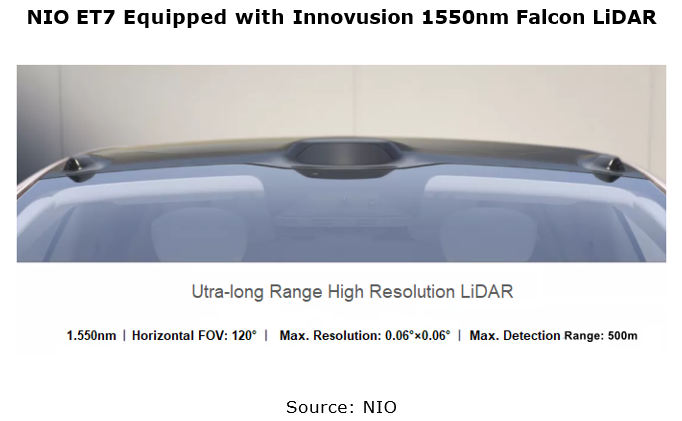
In addition, RoboSense's MEMS LiDAR --- RS-LiDAR-M1 will soon be carried on Lucid Air. RoboSense released the RS-LiDAR-M1 SOP in January 2021, and will start mass production and delivery of the designated project in 2021Q2.
This product adopts RoboSense’s patented MEMS technology, with the farthest detection distance of 200m (150m@10%), the field of view of 120°×25°, and the resolution of 0.2°x0.2°.
In addition to RoboSense, players using MEMS technical solution include Innoviz, AEye, Pioneer, HESAI, Leishen Intelligent Systems, Zvision, etc. The third-generation product of Valeo’s is also based on MEMS technology.
Innoviz's InnovizOne will be installed on the new BMW iX in 2021; Valeo MEMS is expected to see mass production around 2022.
Main MEMS LiDAR Vendors and Their Typical Products
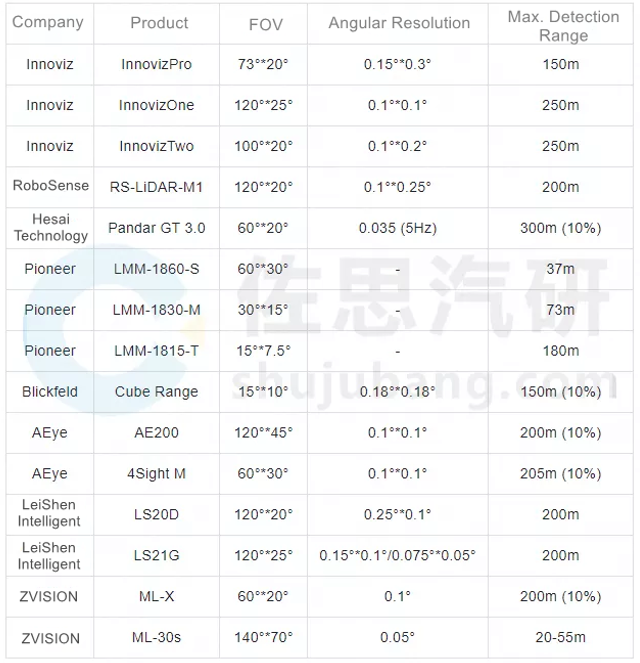
Source: ResearchInChina
New Energy Vehicle Cross-Domain (Electric Drive System and Powertrain Domain) Integration Trend Report 2025-2026
Electric Drive and Powertrain Domain Research: New technologies such as three-motor four-wheel drive, drive-brake integration, and corner modules are being rapidly installed in vehicles.
Electric dri...
Analysis on Desay SV and Joyson Electronic's Electrification, Connectivity, Intelligence and Sharing, 2025
Research on Desay SV and Joyson Electronic: Who is the No.1 Intelligent Supplier?
Both Desay SV and Joyson Electronic are leading domestic suppliers in automotive intelligence. "Analysis on Desay SV ...
OEMs and Tier 1 Suppliers' Cost Reduction and Efficiency Enhancement Strategy Analysis Report, 2025
ResearchInChina released the "OEMs and Tier 1 Suppliers' Cost Reduction and Efficiency Enhancement Strategy Analysis Report, 2025", summarizing hundreds of cost reduction strategies to provide referen...
Automotive Fixed Panoramic Sunroof and Smart Roof Research Report, 2025
With the intelligent application of car roofs as the core, this report systematically sorts out a series of new products such as fixed panoramic sunroof/openable sunroof, ceiling screen, roof ambient ...
Automotive-Grade Power Semiconductor and Module (SiC, GaN) Industry Research Report, 2025
SiC/GaN Research: Sales volume of 800V+ architecture-based vehicles will increase more than 10 times, and hybrid carbon (SiC+IGBT) power modules are rapidly being deployed in vehicles.
Sales volume o...
Cockpit Agent Engineering Research Report, 2025
Cockpit Agent Engineering Research: Breakthrough from Digital AI to Physical AI
Cockpit Agent Engineering Research Report, 2025 starts with the status quo of cockpit agents, summarizes the technical ...
Prospective Study on L3 Intelligent Driving Technology of OEMs and Tier 1 Suppliers, 2025
L3 Research: The Window of Opportunity Has Arrived - Eight Trends in L3 Layout of OEMs and Tier 1 Suppliers
Through in-depth research on 15 OEMs (including 8 Chinese and 7 foreign OEMs) and 9 Tier 1 ...
China Commercial Vehicle IoV and Intelligent Cockpit Industry Research Report 2025
Commercial Vehicle IoV and Cockpit Research: The Third Wave of Passenger Car/Commercial Vehicle Technology Integration Arrives, and T-Box Integrates e-Call and 15.6-inch for Vehicles
I. The third wav...
Intelligent Vehicle Electronic and Electrical Architecture (EEA) and Technology Supply Chain Construction Strategy Research Report, 2025
E/E Architecture Research: 24 OEMs Deploy Innovative Products from Platform Architectures to Technical Selling Points
According to statistics from ResearchInChina, 802,000 passenger cars with domain...
Research Report on Intelligent Vehicle Cross-Domain Integration Strategies and Innovative Function Scenarios, 2025
Cross-Domain Integration Strategy Research: Automakers' Competition Extends to Cross-Domain Innovative Function Scenarios such as Cockpit-Driving, Powertrain, and Chassis
Cross-domain integration of ...
China Autonomous Driving Data Closed Loop Research Report, 2025
Data Closed-Loop Research: Synthetic Data Accounts for Over 50%, Full-process Automated Toolchain Gradually Implemented
Key Points:From 2023 to 2025, the proportion of synthetic data increased from 2...
Automotive Glass and Smart Glass Research Report, 2025
Automotive Glass Report: Dimmable Glass Offers Active Mode, Penetration Rate Expected to Reach 10% by 2030
ResearchInChina releases the Automotive Glass and Smart Glass Research Report, 2025. This r...
Passenger Car Brake-by-Wire (BBW) Research Report, 2025
Brake-by-Wire: EHB to Be Installed in 12 Million Vehicles in 2025
1. EHB Have Been Installed in over 10 Million Vehicles, A Figure to Hit 12 Million in 2025.
In 2024, the brake-by-wire, Electro-Hydr...
Autonomous Driving Domain Controller and Central Computing Unit (CCU) Industry Report, 2025
Research on Autonomous Driving Domain Controllers: Monthly Penetration Rate Exceeded 30% for the First Time, and 700T+ Ultrahigh-compute Domain Controller Products Are Rapidly Installed in Vehicles
L...
China Automotive Lighting and Ambient Lighting System Research Report, 2025
Automotive Lighting System Research: In 2025H1, Autonomous Driving System (ADS) Marker Lamps Saw an 11-Fold Year-on-Year Growth and the Installation Rate of Automotive LED Lighting Approached 90...
Ecological Domain and Automotive Hardware Expansion Research Report, 2025
ResearchInChina has released the Ecological Domain and Automotive Hardware Expansion Research Report, 2025, which delves into the application of various automotive extended hardware, supplier ecologic...
Automotive Seating Innovation Technology Trend Research Report, 2025
Automotive Seating Research: With Popularization of Comfort Functions, How to Properly "Stack Functions" for Seating?
This report studies the status quo of seating technologies and functions in aspe...
Research Report on Chinese Suppliers’ Overseas Layout of Intelligent Driving, 2025
Research on Overseas Layout of Intelligent Driving: There Are Multiple Challenges in Overseas Layout, and Light-Asset Cooperation with Foreign Suppliers Emerges as the Optimal Solution at Present
20...